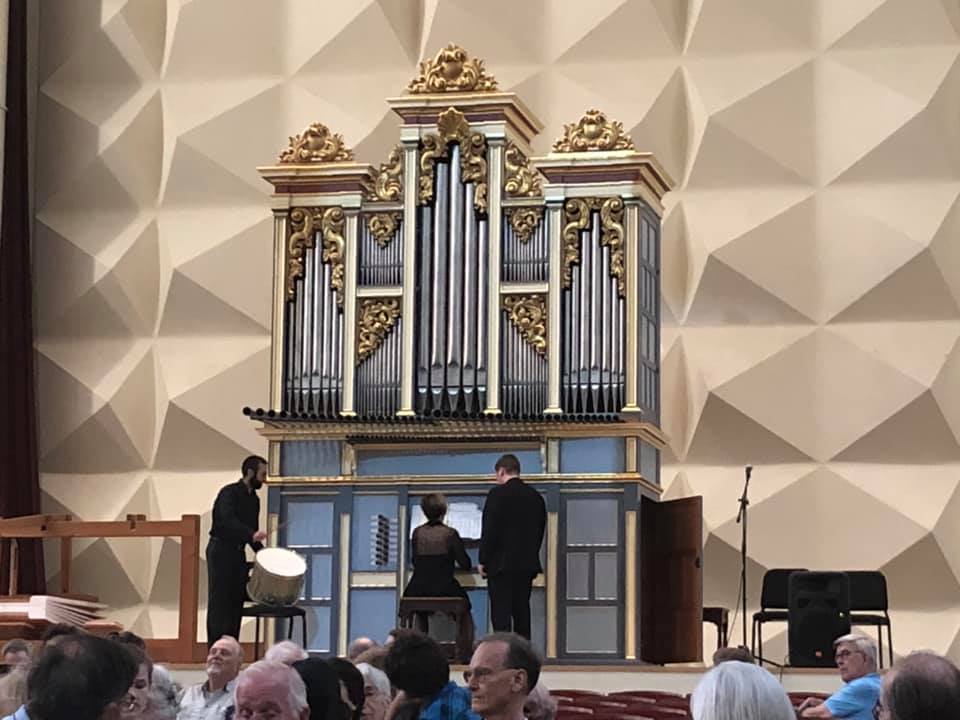by Timothy Robson

Although the new-to-Oberlin organ was built in the 20th century, it is modeled after organs built in Spain and Portugal from the 16th-18th centuries. Iberian organs were often small, but capable of a wide variety of timbres. During the so-called “Golden Age of Spain” in the 17th century, the Cathedral of Toledo boasted no fewer than six organs with elaborate gold decorations.
The Oberlin instrument has a single keyboard, divided in the middle. Different stops can be drawn for the treble and the bass, making it possible to play solo combinations in one hand and accompany them in the other. There is a limited pedalboard of eight keys that look like spatulas.
The organ’s sounds vary from gentle flute stops to stops sounding at higher levels of the harmonic spectrum, as well as brilliant trumpet ranks introduced to Spanish organs in the 18th century. The Harrold features both a Trompeta Real, a brilliant stop mounted vertically inside the case, as well as a Trompeteria, an array of reed stops whose pipes extend horizontally from the front of the case, useful for depicting royalty or playing battle fanfares.
There are also some specialty stops: Pájaros (“birds”) and Cascabeles (“tiny, soft bells”). The Harrold organ can be pumped by hand, but because one of the bellows sitting next to the instrument needed repairs, its electrical blower was used for this concert.
Organist and scholar Kimberly Marshall has established herself as an expert in historically informed performance, having studied with Fenner Douglass at Duke University. Her program on Sunday featured works from Spain and Portugal from the 16th, 17th, and 18th centuries, and included works of the three most famous composers of the time — Antonio de Cabezón (1510-1566), Francisco Correa de Arauxo (1583/4-1654), and Juan Cabanilles (1644-1712) — along with Pablo Bruna (1611-1679) and Portuguese organist Diego da Conceiçào (late 1600s).

The Tiento del Séptimo Tono by Cabezón is based on a melody from the Missa de Beata Virgine by Josquin de Prés, while the Tiento XXV de Medio Registro de Tiple de Séptimo Tono by Correa is perhaps the most elaborate in its inventions. In the wrong hands, these pieces could be deadly boring, but Marshall brought them to life, demonstrating the capabilities of the instrument with varied registrations and subtle phrasing and articulation.
Juan Cabanilles’s Pasacalles de Primer Tono is a set of variations on a repeating bass line. Sophisticated in its use of harmonies, it allowed Marshall to show the color range of the organ.
Another characteristic organ form in Iberia was the Batalha, or “battle music.” The Batalha de 5o Tono by Diego de Conceiçào showed off the trumpets, including a softer reed stop that Marshall used for echo effects. The battle pieces depict fanfares and marching troops that advance and retreat, as well as pastoral scenes following the battle.
Kimberly Marshall was an ideal interpreter of this repertoire on Sunday — scholarly, yet bringing both style and a sense of adventure to the music. As an encore she played a rousing fandango, a typical Spanish dance that hinted at the country’s Islamic heritage.
Oberlin has planned a series of dedicatory recitals during the course of this academic year. Recitalists include Robert Bates (October 24 at 7:30 pm), Jonathan Moyer (November 24 at 4:30 pm), and Guy Bovet (February 29 at 7:30 pm).
Photos by Jonathan Moyer via Facebook.
Published on ClevelandClassical.com September 30, 2019.
Click here for a printable copy of this article



